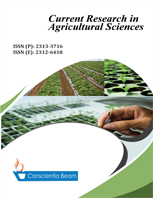Development of an Effective Biocatalyzed Organic Fertilizer Derived from Gliricidia Sepium Stem Biochar
DOI:
https://doi.org/10.18488/journal.68.2021.81.11.30Abstract
Biochar biocatalyst action could improve quality and reduce costs in producing biochar fertilizer. Objective of this study was to develop a high-quality organic fertilizer using biochar biocatalyst action. To activate Gliricidia stem biochar (produced at 400-500oC and 2.5 hours residence time), aqueous biocatalysts were prepared in two separate aerobic reactors containing 4L of water, 12.5 g of rock phosphate, and Gliricidia biocatalyst (GBC) with 1 kg of Gliricidia leaves and market waste biocatalyst (MWBC) with 1 kg of market wastes. Intermittently total 377.5 g and 525 g of biochar were added respectively to the reactors until they reach neutral pH. GBC showed higher total nitrogen (243 mg/L) and available phosphorous (8,125 mg/L) contents. Four compost piles were prepared with fresh immature grass of 18 kg/pile and Gliricidia leaves of 2 kg/pile. Produced biocatalysts were added at the beginning to three piles as 6% GBC, 3% GBC, and 3% MWBC and the control with 6% biochar on dw basis. N, P, K levels of all the compost piles after 8 weeks were within the recommended levels of compost. The highest total nitrogen (20.3 g/kg) and available potassium (83.71 g/kg) remained in 6% GBC and the highest available phosphorous (3.41 g/kg) measured in 3% MWBC. pH values of all piles ranged between 8.8-9.2. The made fertilizer is very suitable and cost-effective for acidic soils to improve soil nutrient status unlike the addition of lime. Michaelis-Menten kinetics indicates that it is preferable to add market waste-like substances to GBC for optimizing the qualities.

